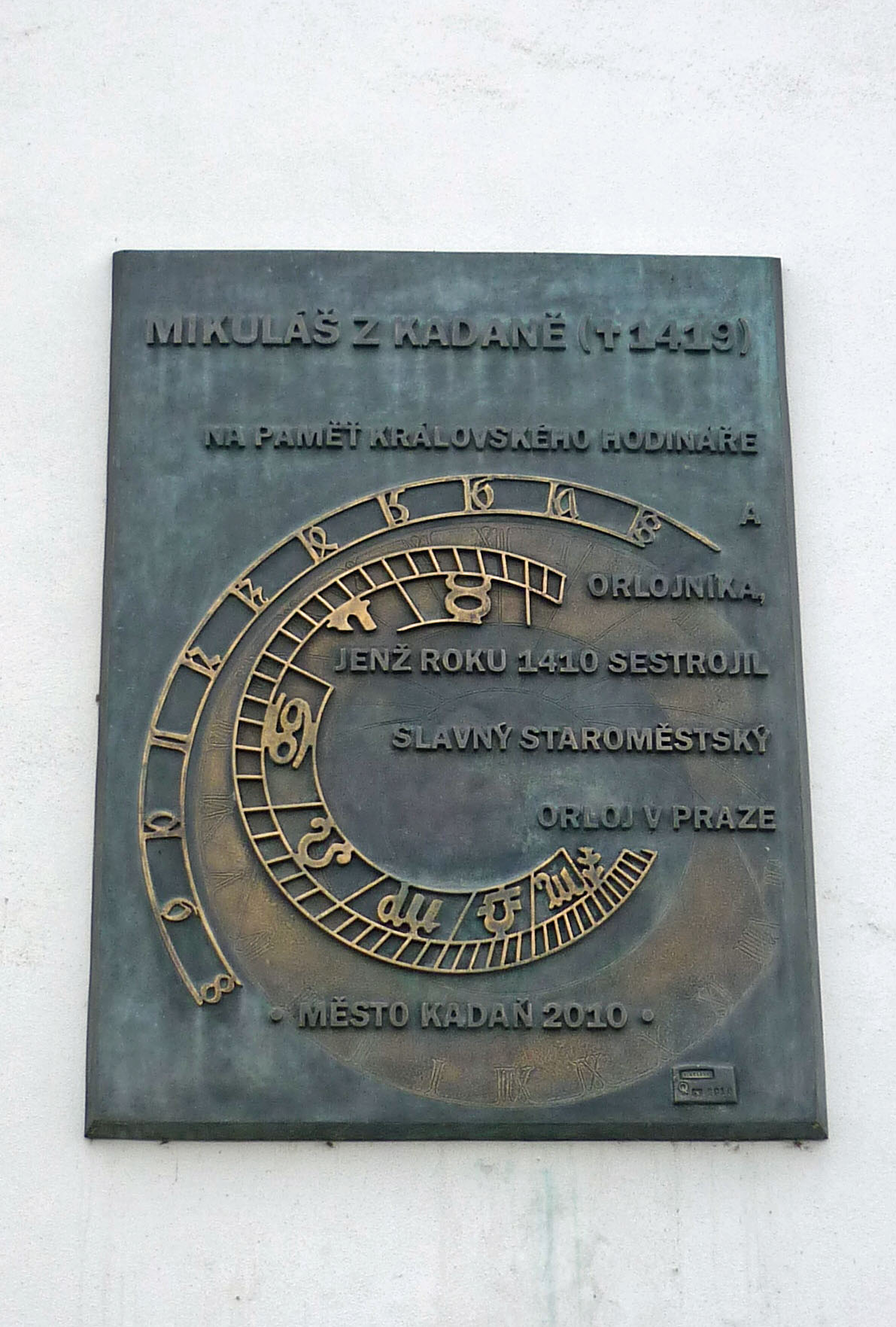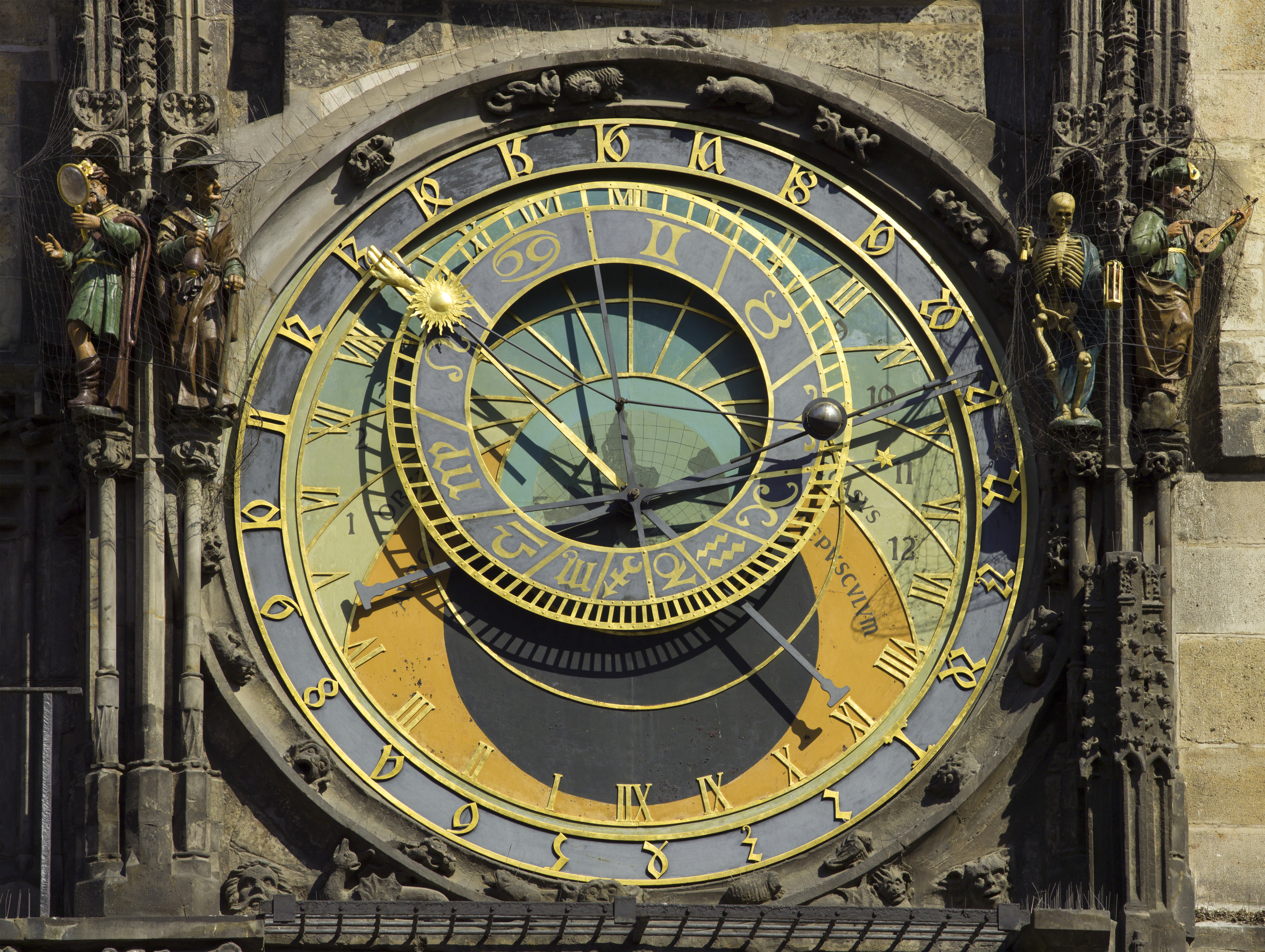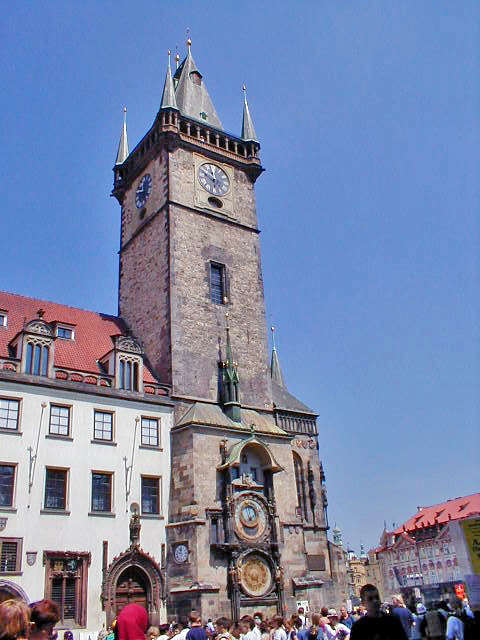|
Mikuláš Of Kadaň
Mikuláš of Kadaň () (born 1350, Kadaň – died 1419, Prague) was an Imperial clockmaker. With Jan Šindel, Mikuláš designed the oldest part of the Orloj (which also known as Prague Astronomical Clock). The clock was modified by Master Hanuš, who was mistakenly identified as the creator of the clock in a legend related by Alois Jirásek. See also * Astronomical clock References 14th-century people from Bohemia 15th-century people from Bohemia Engineers from Prague People from Kadaň 1350 births 1419 deaths Clockmakers {{CzechRepublic-hist-stub ... [...More Info...] [...Related Items...] OR: [Wikipedia] [Google] [Baidu] |
Orloj
An astronomical clock, horologium, or orloj is a clock with special mechanisms and dials to display astronomical information, such as the relative positions of the Sun, Moon, zodiacal constellations, and sometimes major planets. Definition The term is loosely used to refer to any clock that shows, in addition to the time of day, astronomical information. This could include the location of the Sun and Moon in the sky, the age and Lunar phases, the position of the Sun on the ecliptic and the current zodiac sign, the sidereal time, and other astronomical data such as the Moon's nodes for indicating eclipses), or a rotating star map. The term should not be confused with an ''astronomical regulator'', a high precision but otherwise ordinary pendulum clock used in observatories. Astronomical clocks usually represent the Solar System using the geocentric model. The center of the dial is often marked with a disc or sphere representing the Earth, located at the center of the Solar ... [...More Info...] [...Related Items...] OR: [Wikipedia] [Google] [Baidu] |
Kadaň
Kadaň (; ) is a town in Chomutov District in the Ústí nad Labem Region of the Czech Republic. It has about 18,000 inhabitants. It lies on the banks of the Ohře river. Kadaň is a tourist centre with highlights being the Franciscan Monastery in Kadaň, Franciscan Monastery and the historical square with late Gothic Town Hall Tower. The historic town centre is well preserved and is protected as an Cultural monument (Czech Republic)#Monument reservations, urban monument reservation. Administrative division Kadaň consists of ten municipal parts (in brackets population according to the 2021 census): *Kadaň (16,478) *Brodce (20) *Kadaňská Jeseň (114) *Meziříčí (7) *Nová Víska (6) *Pokutice (39) *Prunéřov (252) *Tušimice (351) *Úhošťany (113) *Zásada u Kadaně (6) Etymology The name is most likely derived from the personal name Kadan, meaning "Kadan's (court)". Geography Kadaň is located about southwest of Chomutov and northeast of Karlovy Vary. It lies on the ... [...More Info...] [...Related Items...] OR: [Wikipedia] [Google] [Baidu] |
Prague
Prague ( ; ) is the capital and List of cities and towns in the Czech Republic, largest city of the Czech Republic and the historical capital of Bohemia. Prague, located on the Vltava River, has a population of about 1.4 million, while its Prague metropolitan area, metropolitan area is home to approximately 2.3 million people. Prague is a historical city with Romanesque architecture, Romanesque, Czech Gothic architecture, Gothic, Czech Renaissance architecture, Renaissance and Czech Baroque architecture, Baroque architecture. It was the capital of the Kingdom of Bohemia and residence of several Holy Roman Emperors, most notably Charles IV, Holy Roman Emperor, Charles IV (r. 1346–1378) and Rudolf II, Holy Roman Emperor, Rudolf II (r. 1575–1611). It was an important city to the Habsburg monarchy and Austria-Hungary. The city played major roles in the Bohemian Reformation, Bohemian and the Protestant Reformations, the Thirty Years' War and in 20th-century history a ... [...More Info...] [...Related Items...] OR: [Wikipedia] [Google] [Baidu] |
Jan Šindel
Jan Šindel (1370s – between 1455 and 1457), also known as Jan Ondřejův ( or ''Joannes de Praga''), was a Czech medieval scientist and Catholic priest. He was a professor at Charles University in Prague and became the rector of the university in 1410. He lectured on mathematics and astronomy and was also a personal astrologer and physician of kings Wenceslaus IV of Bohemia and his brother Holy Roman Emperor Sigismund. Life Jan Šindel was born in Hradec Králové probably in the 1370s. As a young man he came to Prague to study at Charles University. In 1395 or 1399, he became the Master of Arts at Prague University. In 1406, he worked at the parish school of the St. Nicolas Church in Malá Strana in Prague. Later he worked as a teacher of mathematics in Vienna, where he also studied medicine. Then he came back to Prague and became the professor of astronomy at Charles University, where he became Doctor of Medicine and rector of the university in 1410. At the beginning he ... [...More Info...] [...Related Items...] OR: [Wikipedia] [Google] [Baidu] |
Prague Astronomical Clock
The Prague astronomical clock or Prague Orloj ( ) is a medieval astronomical clock attached to the Old Town Hall in Prague, the capital of the Czech Republic. Description The Orloj is mounted on the southern wall of Old Town Hall in the Old Town Square. The clock mechanism has three main components – the astronomical dial, representing the position of the Sun and Moon in the sky and displaying various astronomical details; statues of various Catholic saints stand on either side of the clock; "The Walk of the Apostles", an hourly show of moving Apostle figures and other sculptures, notably a figure of a skeleton that represents Death, striking the time; and a calendar dial with medallions representing the months. According to local legend, the city will suffer if the clock is neglected and its good operation is placed in jeopardy; a ghost, mounted on the clock, was supposed to nod its head in confirmation. According to the legend, the only hope was represented by a bo ... [...More Info...] [...Related Items...] OR: [Wikipedia] [Google] [Baidu] |
Master Hanuš
Master, master's or masters may refer to: Ranks or titles In education: *Master (college), head of a college *Master's degree, a postgraduate or sometimes undergraduate degree in the specified discipline *Schoolmaster or master, presiding officer of a school In military: *Master (naval), a former naval rank *Master mariner, a licensed mariner who is qualified to be a sea captain in the merchant marine *Master or shipmaster, the sea captain of a merchant vessel * Master-at-arms, a naval police officer, often addressed as "Master" in the Royal Navy In orders and organizations: *Master craftsman, in the Medieval guilds In other: *Master (form of address), an English honorific for boys and young men *Master (judiciary), a judicial official in the courts of common law jurisdictions *Master (Peerage of Scotland), the male heir-apparent or heir-presumptive to a title in the Peerage of Scotland * Master of ceremonies, or MC (emcee), the host of an official public or private staged even ... [...More Info...] [...Related Items...] OR: [Wikipedia] [Google] [Baidu] |
Alois Jirásek
Alois Jirásek () (23 August 1851 – 12 March 1930) was a Czech writer, author of historical novels and plays. Jirásek was a high school history teacher in Litomyšl and later in Prague until his retirement in 1909. He wrote a series of historical novels imbued with faith in his nation and in progress toward freedom and justice. He was close to many important Czech personalities like Mikoláš Aleš, Josef Václav Sládek, Karel Václav Rais or Zdeněk Nejedlý. He attended an art club in Union Cafe with them. He worked as an editor in ''Zvon'' magazine and was nominated for the Nobel Prize in Literature in 1918, 1919, 1921 and 1930.Josef B. Michl, ''Laureatus Laureata'', ARCA JiMfa, Třebíč, 1995, pp. 372-382 Biography Alois Jirásek was born on 23 August 1851 in Hronov, in the Kingdom of Bohemia (modern-day Czech Republic), which was at that time part of the Austrian Empire. He was born into a family of small farmers and weavers of modest means. His father was Josef Ji ... [...More Info...] [...Related Items...] OR: [Wikipedia] [Google] [Baidu] |
Astronomical Clock
An astronomical clock, horologium, or orloj is a clock with special mechanisms and dials to display astronomical information, such as the relative positions of the Sun, Moon, zodiacal constellations, and sometimes major planets. Definition The term is loosely used to refer to any clock that shows, in addition to the time of day, astronomical information. This could include the location of the Sun and Moon in the sky, the age and Lunar phases, the position of the Sun on the ecliptic and the current zodiac sign, the sidereal time, and other astronomical data such as the Moon's nodes for indicating eclipses), or a rotating star map. The term should not be confused with an ''astronomical regulator'', a high precision but otherwise ordinary pendulum clock used in observatories. Astronomical clocks usually represent the Solar System using the geocentric model. The center of the dial is often marked with a disc or sphere representing the Earth, located at the center of the S ... [...More Info...] [...Related Items...] OR: [Wikipedia] [Google] [Baidu] |
14th-century People From Bohemia
The 14th century lasted from 1 January 1301 (represented by the Roman numerals MCCCI) to 31 December 1400 (MCD). It is estimated that the century witnessed the death of more than 45 million lives from political and natural disasters in both Europe and the Mongol Empire. West Africa experienced economic growth and prosperity. In Europe, the Black Death claimed 25 million lives wiping out one third of the European population while the Kingdom of England and the Kingdom of France fought in the protracted Hundred Years' War after the death of King Charles IV of France led to a claim to the French throne by King Edward III of England. This period is considered the height of chivalry and marks the beginning of strong separate identities for both England and France as well as the foundation of the Italian Renaissance and the Ottoman Empire. In Asia, Tamerlane (Timur), established the Timurid Empire, history's third largest empire to have been ever established by a single conqueror. ... [...More Info...] [...Related Items...] OR: [Wikipedia] [Google] [Baidu] |
15th-century People From Bohemia
The 15th century was the century which spans the Julian calendar dates from 1 January 1401 (represented by the Roman numerals MCDI) to 31 December 1500 (MD). In Europe, the 15th century includes parts of the Late Middle Ages, the Early Renaissance, and the early modern period. Many technological, social and cultural developments of the 15th century can in retrospect be seen as heralding the " European miracle" of the following centuries. The architectural perspective, and the modern fields which are known today as banking and accounting were founded in Italy. The Hundred Years' War ended with a decisive French victory over the English in the Battle of Castillon. Financial troubles in England following the conflict resulted in the Wars of the Roses, a series of dynastic wars for the throne of England. The conflicts ended with the defeat of Richard III by Henry VII at the Battle of Bosworth Field, establishing the Tudor dynasty in the later part of the century. Constant ... [...More Info...] [...Related Items...] OR: [Wikipedia] [Google] [Baidu] |
Engineers From Prague
Engineers, as practitioners of engineering, are professionals who invent, design, build, maintain and test machines, complex systems, structures, gadgets and materials. They aim to fulfill functional objectives and requirements while considering the limitations imposed by practicality, regulation, safety and cost. "Science is knowledge based on our observed facts and tested truths arranged in an orderly system that can be validated and communicated to other people. Engineering is the creative application of scientific principles used to plan, build, direct, guide, manage, or work on systems to maintain and improve our daily lives." The word ''engineer'' (Latin , the origin of the Ir. in the title of engineer in countries like Belgium, The Netherlands, and Indonesia) is derived from the Latin words ("to contrive, devise") and ("cleverness"). The foundational qualifications of a licensed professional engineer typically include a four-year bachelor's degree in an engineering dis ... [...More Info...] [...Related Items...] OR: [Wikipedia] [Google] [Baidu] |








